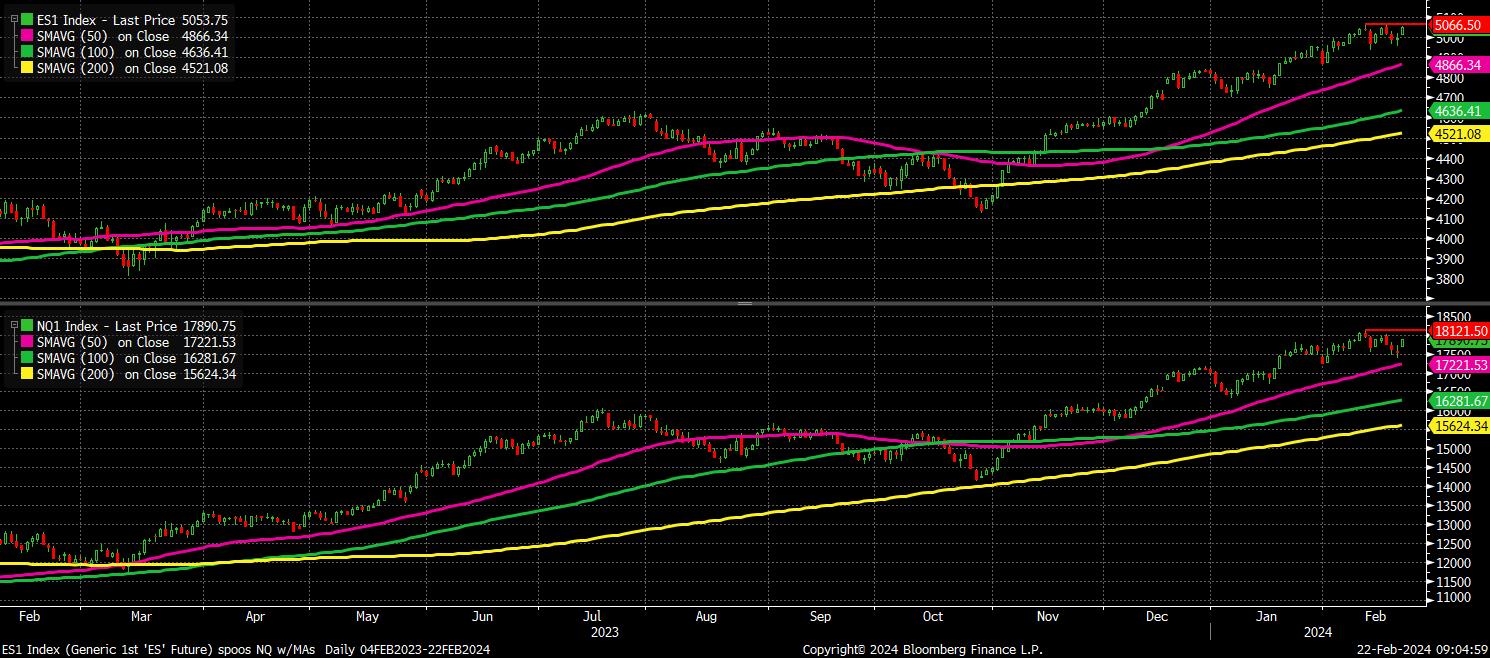To dig into those NVDA results in a bit more detail they were, in a word, stunning – yet again. Fourth quarter revenue printed $22.1bln, around $1.5bln better than the consensus estimate, with the key data centre revenue line – the firm’s biggest sales driver – rising a whopping 409% YoY to $18.4bln in the same period. Adjusted EPS also smashed consensus, printing $5.16 compared to a $4.60 consensus, extending the company’s run of consecutive quarterly upside EPS surprises into a fifth straight report.
Accompanying all this was another round of strong guidance for the quarter ahead, with the firm now seeing first quarter revenue at $24bln, well above street expectations of $21.9bln. Put simply, there wasn’t a single blot on the copybook of a stellar earnings report, hence it was of little surprise to see the stock vault as much as 10% higher in after hours trade, albeit after some initial choppiness as the figures filtered through.
_2_D_2024-02-22_08-57-29.jpg)
Away from the figures themselves, though, the report, and subsequent conference call, produced several interesting nuggets, most with broader implications than being solely a stock-specific story.
The first of these was a reiteration that demand “far exceeds supply” for Nvidia’s next generation products. I’ve heard firsthand from people much closer to the sector than me of months-long lead times for certain products, which only NVDA seem able to provide at present, which naturally causes a surge in price. To this end, it would appear, perhaps, that the biggest factor behind NVDA’s continuing success is not necessarily solely down to what the firm itself may do going forward in terms of innovation, but may lie more with how, and indeed if, the competition is able catch up both in terms of technological prowess, and production level, in the short-term. At present, with demand “surging worldwide” across companies, industries, and nations, Nvidia and their quasi-monopolistic domination of the AI space, are making hay while the sun shines.
That surge in demand brings me to an important line from Jensen Huang, NVDA CEO, who noted that accelerated computing and generative AI have now “hit the tipping point”. Thankfully, for NVDA bulls at least, this referred to a tipping point where the aforementioned technologies will become increasingly ‘mainstream’.
If you were looking for a macro theme from the Nvidia report, there you have it – AI usage increasing, helping to improve what has been a long-running crippling global slump in productivity, and perhaps even shifting the longer-run monetary and fiscal policy paths as a result. I would caution, though, that this is all in the very distant future, and not something to become over-excitable about just yet.
However, in the here & now, NVDA’s blowout report does clear what was, arguably, the biggest short-term risk facing financial markets, and provide a huge green light for risk assets to continue taking the path of least resistance to the upside.
Purely by virtue of NVDA being the S&P 500’s 3rd largest, and Nasdaq 100’s 4th largest, constituent, both indices have pushed back towards the prior YTD, and record, highs since earnings dropped.

Looking ahead, further fresh highs seem likely to be on the cards, particularly with the policy backdrop – as discussed at some length lately – set to remain supportive with rate cuts coming from summer onwards, quantitative tightening set to conclude soon (discussions on which will take place at the March FOMC), and central banks having also proved on countless occasions recently that they are ready, willing, and able to step in with sizeable targeted liquidity injections as and when necessary. In layman’s terms, the central bank put is alive, flexible, and well, and is a powerful force one would be unwise to fight.
In terms of near-term catalysts, there are few of note until the next US PCE figures next Thursday, though markets have probably discounted these coming in on the hot side already, after last week’s upside surprises in the CPI and PPI figures, and subsequent hawkish repricing of Fed policy expectations, with the first cut now foreseen in June.
After PCE, we look to the next ISM manufacturing and services PMI prints, on 1st and 5th March respectively, before focus turns to the February labour market report on 8th March. This latter print is, by far, the most important of the bunch, with the supportive policy backdrop and continued strong US economic momentum both likely to keep equities underpinned, and dip demand substantial, for some time to come.
Related articles
此处提供的材料并未按照旨在促进投资研究独立性的法律要求准备,因此被视为市场沟通之用途。虽然在传播投资研究之前不受任何禁止交易的限制,但我们不会在将其提供给我们的客户之前寻求利用任何优势。
Pepperstone 并不表示此处提供的材料是准确、最新或完整的,因此不应依赖于此。该信息,无论是否来自第三方,都不应被视为推荐;或买卖要约;或征求购买或出售任何证券、金融产品或工具的要约;或参与任何特定的交易策略。它没有考虑读者的财务状况或投资目标。我们建议此内容的任何读者寻求自己的建议。未经 Pepperstone 批准,不得复制或重新分发此信息。。。


